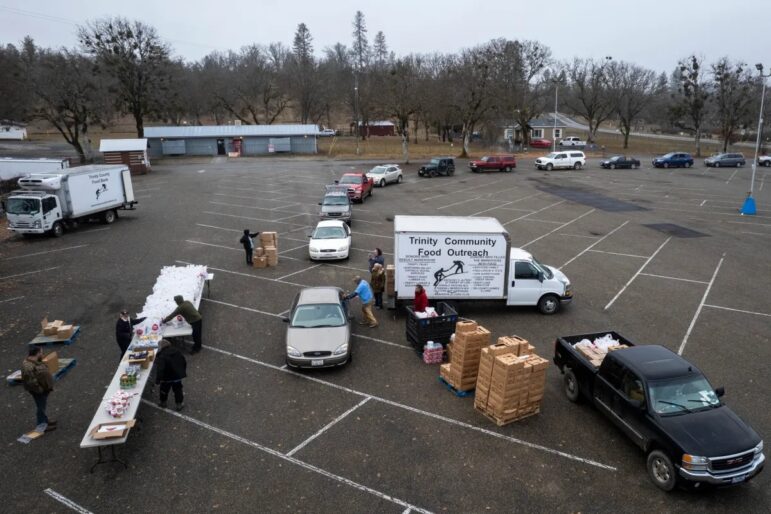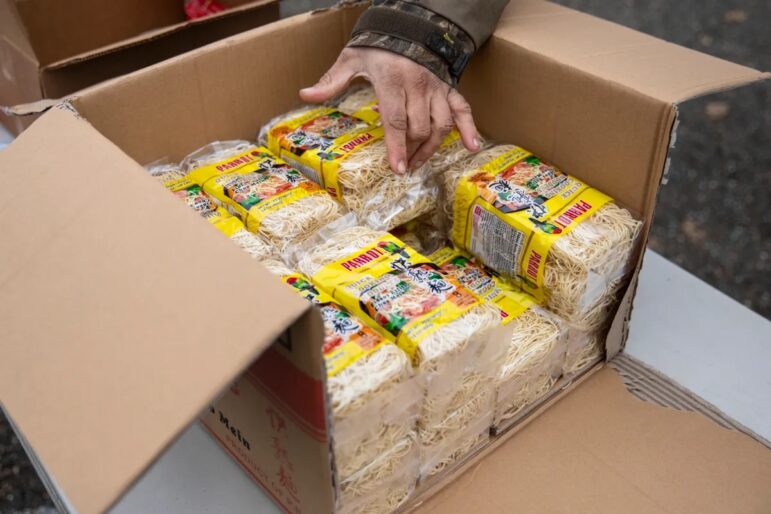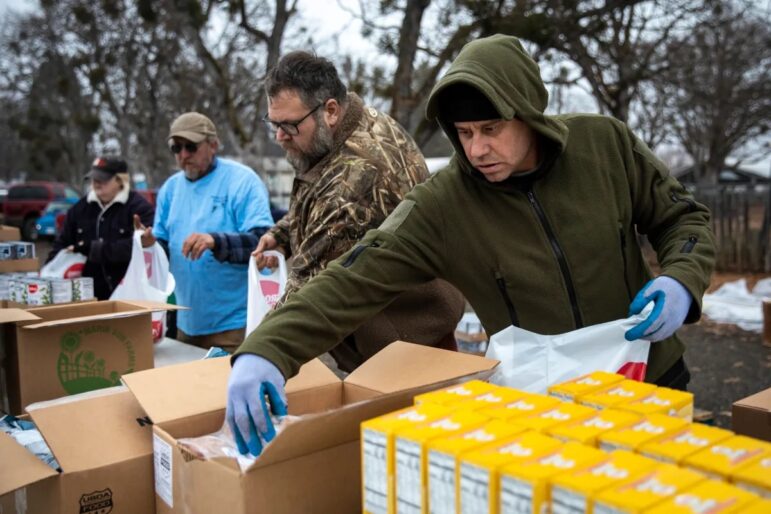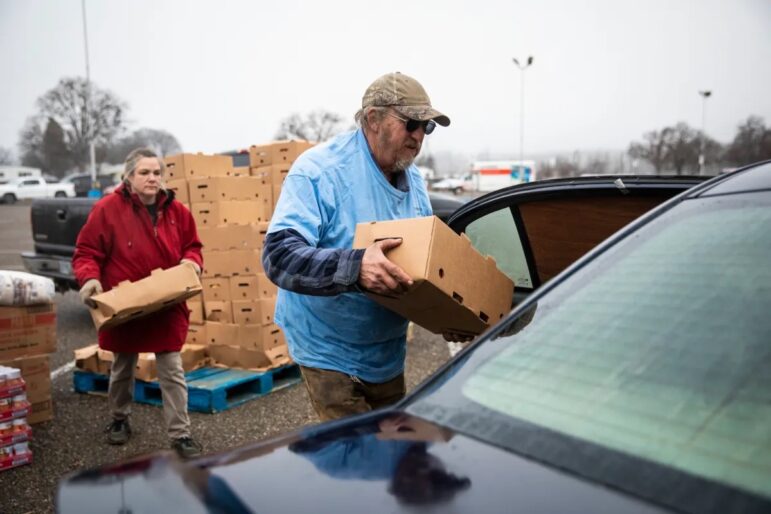HAYFORK — It’s shortly before 8 a.m. and a touch above freezing at the Trinity County Fairgrounds. The food bank’s February distribution won’t begin for another half hour, but the line of cars already stretches into a third row of the parking lot.
Joseph Felice, his red Dodge pickup idling with the heat cranked up, arrived around 7 to secure a spot near the front — eighth, to be exact — and ensure that he gets his pick of this month’s harvest: frozen catfish filets, eggplant, winter squash, potatoes, cans of mixed fruit, cartons of milk. Getting here early is crucial, because by the time the final cars roll through some two hours later — 210 families served — all that’s left are a few packages of diapers and noodles.
Things are getting desperate in this remote, mountainous community in far northern California, where cannabis is king — the economy, the culture, the everything. Over the past two years, the price of weed has plummeted and people are broke.
The monthly food bank distribution moved from a church to the fairgrounds last summer to accommodate surging demand. There’s only one sit-down restaurant left in town, a Mexican joint that closes every day at 6. Some residents have fled for Oklahoma, where it’s easier for cannabis cultivators to get licensed. Others are stuck, unable to unload their properties amid an abundance of supply and a dearth of demand.
“I don’t see the same faces that I did before,” said Felice, 67, who performed maintenance work for a local grower for five years, until they called it quits at the end of last season.
Felice lost not just his income, but also free housing on the farm. The food distribution is now a crucial bridge between Social Security checks and trips to Redding, 60 miles away, where he can get cheaper groceries.
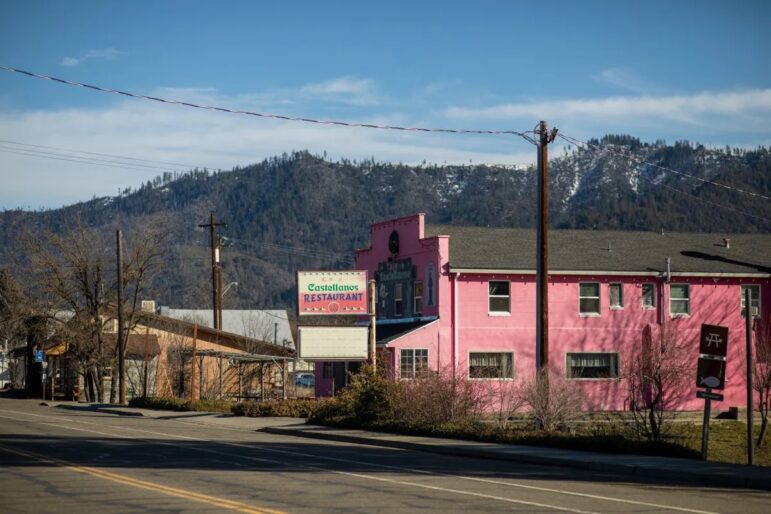
“I had plenty of money working out there,” Felice said. “But now that it’s gone, you have to do something.”
Just what that something might be for Hayfork — and the rest of the famous Emerald Triangle of Humboldt, Mendocino and Trinity counties — is unclear.
For decades before California legalized recreational cannabis in 2016, this rural region of about 245,000 people was the base of weed cultivation for the entire country. The effects of the price crash, which has been particularly acute in the past two years, can be felt throughout the three counties, both within the industry and far outside of it.
Cultivators who can barely make ends meet are laying off employees, slashing expenses or shutting down their farms. That means money isn’t flowing into local businesses, nonprofits are getting fewer generous cash donations in brown paper bags, and local governments are collecting less in sales and property taxes.
Workers who spent their whole lives in the cannabis industry are suddenly looking around for new careers that may not be there. Store clerks, gas station attendants and restaurant servers who relied on their patronage now find themselves with reduced hours, meager tips or out of a job altogether.
A sense of despair and heartbreak has taken hold in many communities. People whisper about friends who are thinking about divorce or who killed themselves because they could not handle the financial devastation. And the pain is compounded by a feeling that their suffering has been all but invisible, overlooked by most Californians and dismissed by government officials who have never made good on the promises of legalization.
“We’re constantly at war. That’s how it feels,” said Adrien Keys, president of the Trinity County Agriculture Alliance, a trade association for the local legal cannabis industry.
These communities have been here before, stuck in a boom-and-bust cycle that played out with gold mining and cattle ranching and fishing. The last time, when the timber industry collapsed in the 1990s, cannabis cultivation flourished after the legalization of medical marijuana and filled the void. Now it’s unclear whether there’s anything left to sustain the local economies.
Some imagine that growing tourism can be the salvation, or attracting new residents with remote jobs and a desire to live way off the grid, or perhaps a logging revival driven by the urgent need to thin out California’s wildfire-prone forests. Others hope that a cannabis turnaround might still be possible.
But for a small, isolated town such as Hayfork — population: 2,300; high school student body: 88; empty sawmills: two — the answers are not obvious. The fear that the community could ultimately wither away is real.
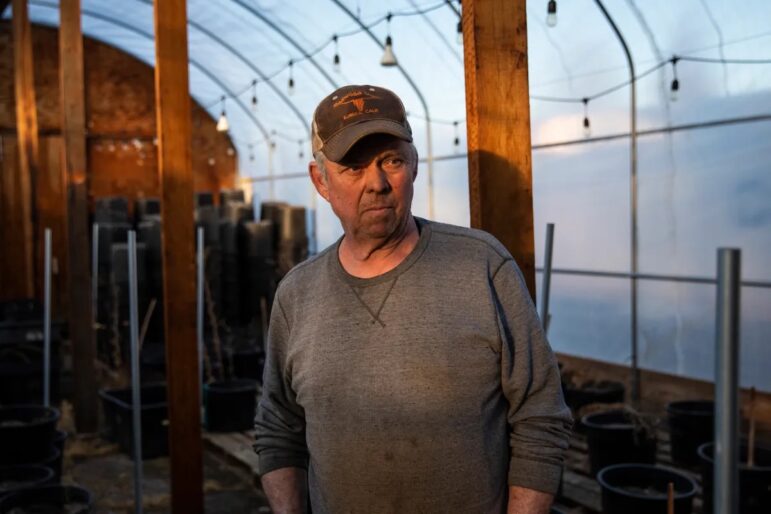
“Long-term, I’m worried about it,” said Scott Murrison, a 68-year resident of Hayfork who owns half a dozen local businesses, including the gas station and mini mart (revenues down 10-15% over the past few years), a grocery store (down by as much as a third), the laundromat (bringing in about half of what it did when it opened a decade ago), a bar (stabilized since adding food to the menu), a ranch (hanging on, because there’s still demand for locally-raised beef) and a couple of greenhouses (leased to his nephew, who is not growing cannabis this year).
Without any real opportunities for young people coming out of school, Murrison said, they will have to move away, leaving Hayfork without a future.
“A good, viable community needs those families and the young people,” he said. “A bunch of old people are just boring.”
It wasn’t supposed to go this way.
Cannabis should have been the sustainable alternative to gold and timber, a renewable resource that can be replanted each year. For a long time, it was.
Despite the challenges of growing an illegal crop, including enforcement raids that still scar residents, the “war on drugs” kept product scarce and prices high. The lure of easy cash attracted people from around the world to the Emerald Triangle, an annual flow of “trimmigrants” who could walk away from the fall harvest season with thousands of dollars in their pockets, much of which was spent locally.
“Everybody was making so much money it was insane,” Murrison said. “You could be here by accident, you could make money. Either trimming or growing or hauling water or if you had equipment, leveling spots or digging holes.”
Then came Proposition 64, the ballot initiative approved by California voters in 2016 that finally legalized recreational cannabis use and commercial sales in the state, though they remain illegal under federal law. Proponents including Gov. Gavin Newsom pitched it as both a social justice measure and a boon for tax revenues.
But the “green rush” that resulted has arguably harmed the Emerald Triangle more than it helped.
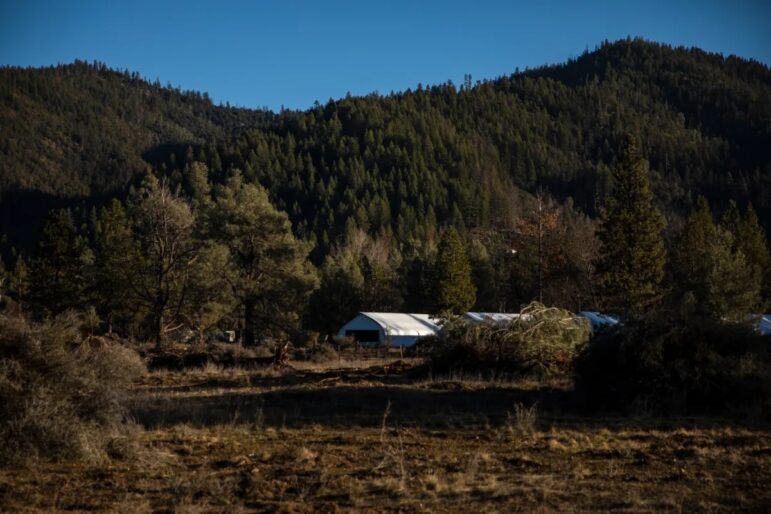
New farmers, sometimes licensed and often not, streamed in, flooding the market with cannabis. A cap on the size of farms intended to give small growers a head start was abandoned in the final state regulations, opening the door to competing cultivation hubs in other regions of California with looser restrictions. And with most local jurisdictions still closed to dispensaries, the legal market has been unable to absorb the glut, resulting in plunging prices and a vicious cycle in which farmers grow even more weed to make up for it.
Cultivators who might have commanded more than $1,000 for a pound of cannabis just a couple years ago said it is now selling for a few hundred dollars, not enough to break even with their expenses, taxes and fees.
Commercial cannabis sales in California actually fell by 8% last year to $5.3 billion, according to just-released state tax data, the first decline since it became legal in 2018 and a further cramp on the industry. State tax revenue dropped from $251.3 million in the third quarter of 2022 to $221.6 million in the fourth quarter.
“You can’t keep printing a dollar,” said Trinity County Supervisor Liam Gogan, who represents Hayfork and nearby Douglas City, where he said business at his grocery store is down an estimated 20%, a decline he expects is less than many other shops in town.
Some parts of the Emerald Triangle are better positioned to weather the cannabis downturn; the coast is a tourist draw, the newly rechristened Cal Poly Humboldt in Arcata is undergoing a major expansion and there are government jobs in the county seats.
But things are precarious in the vast rural expanses, which is most of Trinity County, where there are no incorporated cities. It has one of the smallest and poorest populations of any county in California — just 16,000 residents and a median household of about $42,000 a year. Outside of the Trinity Alps Wilderness in its northern reaches, there is little economy beyond weed.
“It’s what we got,” said Gogan, who dismisses the possibility of tourism or any other industry offsetting cannabis losses as delusional. “No one’s knocking the door down.”
Like many locals, he dreams that, with the exodus of cultivators and a drop in production, cannabis prices could rebound slightly. Some are noticing a modest recovery recently from the bleak depths of last year, when the most distressed farmers offloaded their product for fire-sale prices below $100 per pound, or simply destroyed crops they couldn’t sell.
There have been nascent efforts at the state Capitol to help small cannabis growers. Newsom and legislators agreed last year to eliminate a cultivation tax after farmers from the Emerald Triangle lobbied aggressively for relief. But the intervention is far from enough to ensure their future in a turbulent cannabis market.
State Sen. Mike McGuire, a Democrat who represents the north coast, blamed Proposition 64 for setting up family farmers for failure with a litany of “suffocating rules.” He is preparing to introduce legislation this spring that could undo some of those regulations for small growers, including an “antiquated, cockamamie licensing structure” that requires them to keep paying annual fees even if they fallow their land because of the price drop and a ban on selling cannabis directly to consumers, something that is allowed for other agricultural products.
“These are solutions that will help stabilize the market and lift up family farmers for generations to come,” McGuire said. “The state needs to have a backbone to get it done.”
Newsom, who once called himself the “poster child” for “everything that goes wrong” with Proposition 64, declined a request to discuss what’s happening in California’s historic cannabis communities. A spokesperson directed CalMatters to the Department of Cannabis Control, which did not make Director Nicole Elliott or anyone else available for an interview.
In a statement, spokesperson David Hafner said the department has “made a point of regularly monitoring and visiting the Emerald Triangle and engaging directly with licensees to understand their challenges in real time.”
Hafner said the department has advanced “several policies and programs that have directly or indirectly supported legacy growers in the Emerald Triangle,” including granting more than 1,000 fee waivers to cultivators in the region, revising regulations to more closely align with traditional farming practices and providing $40 million to bolster licensing efforts in the three counties.
“The Department stands ready to assist policymakers,” Hafner said, “in developing actions that improve the legal cannabis market.”
Though growers in the Emerald Triangle have been sharply critical of how the state has regulated cannabis, particularly its early decision to forgo a strict acreage cap, one recent development may be promising: In January, Elliott requested an opinion from the state Department of Justice about what federal legal risk California would face if it negotiated agreements with other states to allow cannabis commerce between them.
That could eventually open a pathway for growers to export their weed out of California, a market expansion that some believe is the kick-start that their operations need.
The escape hatch may be closing for those seeking a way out of the industry.
When the value of cannabis dropped, so did the worth of the properties where it’s grown — even more so for the many farmers who, because of environmental lawsuits and bureaucratic negligence, have yet to receive final approval for their state-issued cultivation licenses. After years of operating on provisional licenses, they still do not technically have a legal business to sell to an interested buyer, if they could even find one.
Some are simply abandoning the properties that they have built into farms with greenhouses and irrigation systems, though evidence of this dilemma is anecdotal. The Trinity County Assessor’s Office said it could not provide data on recent property sales levels or prices.
“There’s no way I could get out of my property now what I put into it,” said Keys of the Trinity County Agriculture Alliance, who figures he would be forced to walk away entirely if he stopped growing. “I don’t know if I could sell it at all.”
For those residents who stay, the strain is only deepening.
The number of people in Trinity County enrolled in CalFresh, the state’s monthly food benefits program, in December was 31% higher than the year before and more than 71% higher than the same period in 2019, before the coronavirus pandemic and inflation crisis, according to data compiled by the California Department of Social Services. That’s nearly three times the rate of increase for the entire state.
Jeffry England, executive director of the Trinity County Food Bank, said his organization is handing out two and a half times as much food as when he took over the position six years ago. He estimates that the food bank serves about 1,200 families per month, as much as a fifth of the whole county’s population. It has added three new distribution sites in the past year.
“It’s getting really bad,” England said. “There are some of them who are in line at the food bank who used to be our donors.”
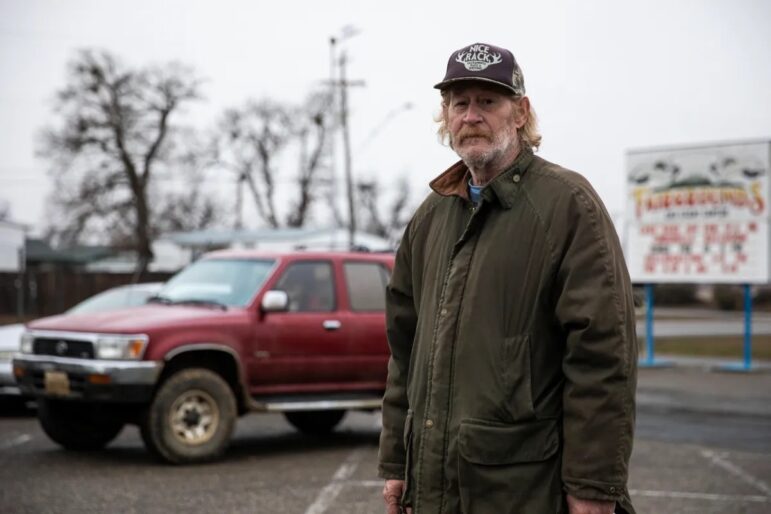
Not everyone who is struggling dreams of leaving Hayfork behind.
Herlinda Vang, 54, arrived about seven years ago from the Fresno area, where she worked as a social worker at a nonprofit and grew vegetables near Clovis. Sensing the opportunity of recreational legalization, she moved months before the passage of Proposition 64 to start a cannabis farm.
Vang has come to appreciate how safe and quiet the community is compared to a big city, where she worried about her youngest children, now 14 and 11 years old. She can hear the birds when she wakes up in the morning.
“What I’m doing is also helping other people, saving other people’s life, too,” she said. “So that is something that I enjoy doing.”
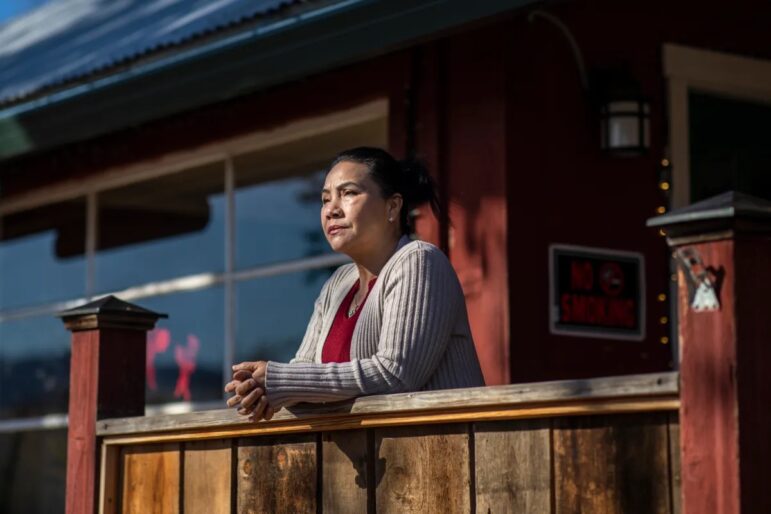
But last year, Vang had difficulty getting county approvals and wasn’t able to start growing until mid-July, about six weeks later than she wanted. Her plants were small by harvest time, leaving her with less to sell at the already reduced prices.
Even as she is making less than a third per pound now compared to when she first started growing, Vang remains committed to her farm for at least another few years to see if things will turn around — especially if interstate trade opens up and expands the market.
Without many other skills or job prospects locally, she doesn’t expect she could make much more money than she does now trying to find more traditional work. She also loves that, on her farm, she sets her own rules and schedule, and is able to prioritize being a mother as well.
“I cannot give up. I have put everything I have in here,” Vang said. “I have to hang in there for a couple more years and see if I can make it work.”
That has meant sacrifices. Vang has stopped shopping online for new clothes and jewelry, sending money overseas and buying pricier groceries, such as seafood. She gave away three of her nine dogs and only takes her family out to dinner on rare occasions.
Like many of her neighbors, Vang now supplements her pantry with staples from the food bank, though like many of her neighbors, she is also doing her part to hold the community together, helping to coordinate a new distribution site in Trinity Pines, a mountain settlement of predominantly Hmong farmers. A Facebook group called Hayforkers has become a forum for people looking for assistance or giving away extra food and household items.
“I am a very tough person,” Vang said. “I’m happy that even though my income is not the same, but my family, my health remains the same and the people that I know, the community at large still love each other, still comfort each other.”
Ira Porter is also on a shoestring budget. He covers his $200 per month rent by collecting cans and bottles — there are fewer than there used to be — from people who don’t want to travel all the way to the county seat of Weaverville or Redding to turn them in.
Porter, 59, used to do maintenance and repair work on cannabis farms, fixing cars, water systems, and trimming machines. His wife was a trimmer.

“I’d be busy all year round, you know, because there’s always something to do,” Porter said through the window of his white Volkswagen sedan as he waited at the Hayfork food distribution with his pug Biggee in his lap. “I don’t know how many of these farmers left, but I’m not getting any calls this year as far as to do that.”
As the line of cars slowly worked its way through the parking lot of the Trinity County Fairgrounds, past the volunteers handing out boxes of vegetables and bags of noodles, Porter cataloged the things he loves about Hayfork: The open spaces. The fresh air. Hanging out at the creek looking for gold. Being able to leave the keys in his car at night and not having to lock the door to his house. Chopping wood for kindling in the winter.
“I moved up here to get out of L.A. because it’s a zoo down there, and there’s just too many people, and they’re all pissed off because they don’t got no elbow room,” Porter said. “Up here, it’s just beautiful. I love this place, you know? I mean, cannabis industry or not, I want to live here and die here.”

